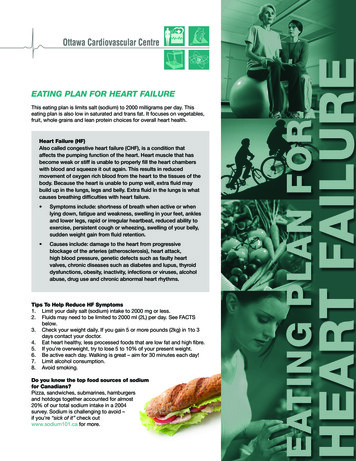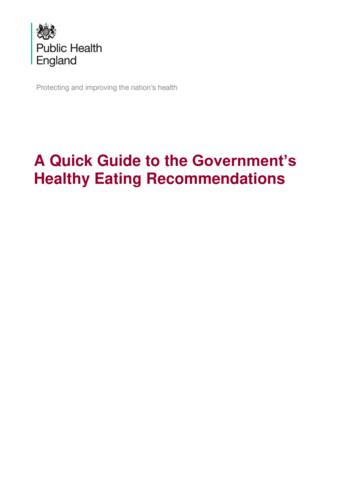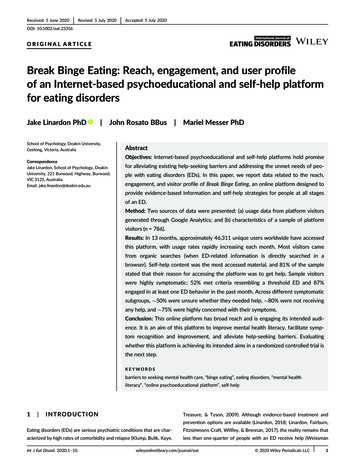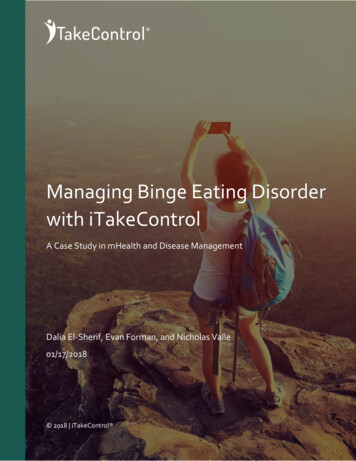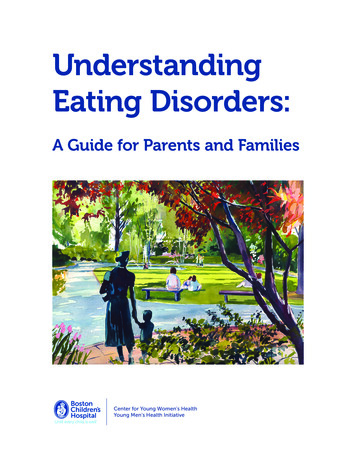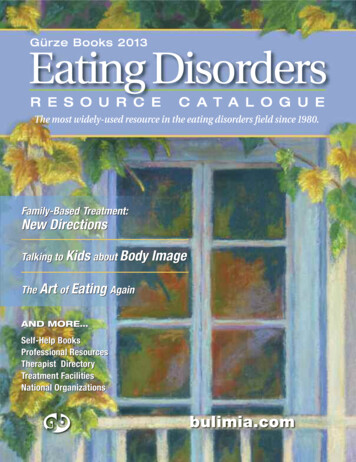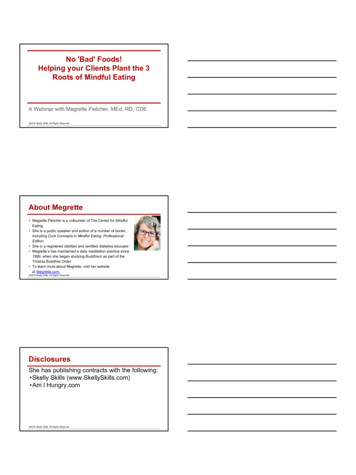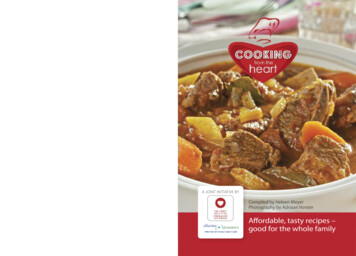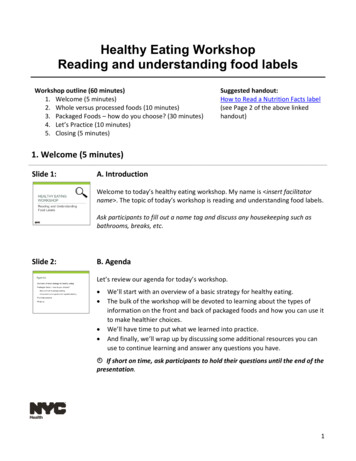
Transcription
Healthy Eating WorkshopReading and understanding food labelsWorkshop outline (60 minutes)1. Welcome (5 minutes)2. Whole versus processed foods (10 minutes)3. Packaged Foods – how do you choose? (30 minutes)4. Let’s Practice (10 minutes)5. Closing (5 minutes)Suggested handout:How to Read a Nutrition Facts label(see Page 2 of the above linkedhandout)1. Welcome (5 minutes)Slide 1:A. IntroductionWelcome to today’s healthy eating workshop. My name is insert facilitatorname . The topic of today’s workshop is reading and understanding food labels.Ask participants to fill out a name tag and discuss any housekeeping such asbathrooms, breaks, etc.Slide 2:B. AgendaLet’s review our agenda for today’s workshop. We’ll start with an overview of a basic strategy for healthy eating.The bulk of the workshop will be devoted to learning about the types ofinformation on the front and back of packaged foods and how you can use itto make healthier choices.We’ll have time to put what we learned into practice.And finally, we’ll wrap up by discussing some additional resources you canuse to continue learning and answer any questions you have. If short on time, ask participants to hold their questions until the end of thepresentation.1
Slide 3:C. ObjectivesAfter today’s workshop, you will: Know where to find reliable information on food packaging Understand how to verify information on the front of food labels Be able to use information on food packaging to make healthy andinformed food choices2. Whole Versus Processed Foods (10 minutes)Slide 4:A. Whole foodsBefore we dive into today’s topic, let’s review a broad strategy for healthyeating. Choosing whole and minimally processed foods more often thanprocessed foods is one way to eat healthier.Whole foods are foods to which nothing is added and nothing is taken away.When food is processed, unhealthy fat, sugar and salt usually get added. All areingredients that can contribute to your risk of developing a chronic disease.Vitamins, minerals and fiber are all components that contribute to thenutritional value of foods and usually get taken away during processing.Some examples of whole foods are fresh fruits and vegetables, whole grains,nuts, legumes and eggs.You can think of all foods as being on a spectrum of whole foods to highlyprocessed foods. We all eat foods from the entire spectrum. But choosing to eatmostly whole foods or minimally processed foods is a strategy you can use toeat healthier. Let’s see what that means.Slide 5:B. Whole vs. Processed FoodsLet’s look at how this concept applies to foods in the fruits, vegetables, proteinand grains food groups. As you can see in the first column, the most wholefoods from each of these food groups are the healthiest. These include freshfruits and vegetables; whole grains, such as oats; vegetable-based proteins, likebeans and lentils; and lean cuts of meat.2
As foods become more processed, they lose some nutrients or gain someunhealthy components. These minimally processed foods can still be goodoptions and contribute to a healthy diet. Foods in this minimally processedcategory include frozen fruits and vegetables, canned fruits and vegetables,white rice or homemade meatballs.When choosing canned fruits and vegetables, what are some things you can doto make them healthier? Buy fruit packed in 100% juice, not in syrup or light syrup Buy low or no sodium canned vegetables Rinse canned vegetables before eatingWhat about when choosing frozen fruit or vegetables? What can you do tochoose healthier options? Read the ingredients list and choose frozen fruits and vegetables thatdon’t contain added ingredients.Foods in the most processed category are french fries, sugary cereals and hotdogs. These are the least healthy for you because they contain a lot of addedsugar, salt and unhealthy fat and have been stripped of a lot of nutrients. Youshould avoid eating too much of these types of foods.One thing to note is that the way you cook and prepare your food plays a role inhow healthy it is. Try cooking your food with little added salt and sugar andusing healthier fats, such as vegetable oils instead of lard or butter.Slide 6:For dairy foods, the whole versus processed strategy is a little different. In thecase of dairy foods, processing dairy-based foods can make them healthier. Forexample, processing whole milk to remove some of the saturated fat gives usone percent milk. As more saturated fat is removed, the milk becomes lower intotal fat and calories but keeps the same amount of healthy nutrients we getfrom milk, such as calcium and vitamin D. However, flavoring milk by addingextra sugar makes it less healthy.Skim and low-fat, plain milk and yogurt are recommended for anyone over twoyears of age as they provide calcium, vitamin A and D protein, less saturated fatand fewer calories than other dairy products.The least healthy dairy-based foods are those with a higher fat content and withmore added sugars and salt. These include ice cream, flavored yogurt andprocessed cheeses. You should eat these foods more sparingly.3
We know that we all include at least some foods that are processed andpackaged in our diets. It’s impossible to avoid packaged foods in this modernworld, and they can have a place in a healthy diet. Today, I’m going to give yousome tools to think critically about the information available to you onpackaged foods so that you can make healthier choices.Note to facilitator:Participants may express that they have heard conflicting information aboutdairy foods, saturated fat and whole milk. You can address their concerns bysaying that, until more research is completed, the Dietary Guidelines forAmericans still recommends that anyone two years of age or older consume lowfat or fat-free dairy.Slide 7: If short on time, do this activity as a group brainstorm instead of in pairsWhen buying packaged foods, you have to become somewhat of a detective tosort through all of the information that’s available to you. I’d like to hear fromyou about what information you look at and use on food packages to make yourchoices. Turn to a person next to you and share what you do.Let the group discuss for a few minutes. Then, invite one to two people to sharewhat they told their partner.Thanks for sharing. Clearly, there is a lot of information available to use on foodpackaging and we all have different reasons for choosing the foods we choose.Throughout today’s workshop, we’ll be examining the most reliable sources ofinformation on food labels. We’ll also talk about some of the other sources ofinformation available to you and how you can use it to make your foodshopping experience easier.3. Packaged Foods – How Do You Choose? (30 minutes)Slide 8:A. Packaged foodsThe United States Department of Agriculture (USDA) and the Food and DrugAdministration (FDA) both share responsibility for food labeling. Everythingon a label is true, but not all of it is meaningful.4
The information on the back of the package is the most reliable. This includesthe ingredients list and the Nutrition Facts label.The front of the package has a whole host of additional information. Some ofthis is nutrient content claims, health claims and a variety of seals,certifications and graphics. This is what you first see when you’re scanningthe shelves of a grocery store, and it’s often designed to be very eye catching.We’ll talk through some of this information and help you figure out how tosort through it and pick out what is useful for you to make a healthy choice.Slide 9:B. Back of Package LabelingAgain, the back of the package gives you the most reliable information onwhat is in the food you are buying. This is in the form of the ingredients listand the Nutrition Facts label. These two sources of information on the back ofthe package give you specific information on what is in that food.These two sources of information are also very useful if you want to avoid,limit or increase certain nutrients or ingredients. They are also useful whencomparing two products within the same food category.Slide 10:i. Ingredient ListsLet’s start with the ingredient list which tells you a lot about a food product. Ingredient lists should be short, recognizable and readable.Ingredients should sound like food.The first ingredient should be a healthy one (ingredients are listedfrom most to least). For example, when choosing 100% whole-wheatbread, “whole-wheat” should be the first ingredient.There should be no partially hydrogenated oils.Limit foods that have a lot of added sugars.o Fructose, high fructose corn syrup, corn syrup, corn sweetener,sucrose, glucose, dextrose, granulated, brown, cane and invert sugar,honey, maple syrup, agave syrup, fruit juice concentrate, evaporatedcane juice and molasses can all be added sugars.Share the additional information below for the final three bullets. First ingredient is a healthy one. When purchasing whole-wheatproducts, look for 100% whole on the front of the package or “wholewheat” as the first ingredient in the ingredient list.5
No partially hydrogenated oils (PHOs). This ingredient is the primarysource of artificial trans fat in processed foods. Research has shown thatremoving PHOs from processed foods could prevent thousands of heartattacks and deaths each year. There has been a decline of PHOs in foodsince the mid-2000s. In 2016, the FDA ruled that PHOs are no longer safefor use in foods and food companies must stop using these oils in theirproducts. Food companies have up to three years to comply with thisruling. This means that companies can either reformulate their productswithout PHOs or seek permission from the FDA to use the oils in certainproducts. Either way, you will see a drop in the use of PHOs in foods. Fornow, make sure this ingredient is not in your ingredient list. Limited number of added sugars. If any of these words for added sugarsare in an ingredient list that means that sugars have been added in someform. All of these types of sugars regardless of the color, shape or namecontain the same amount of calories. If you want to choose a product thathas little or no sugar added, watch out for these ingredients.Slide 11:Let’s test your knowledge and compare these two ingredient lists – one is forstrawberry flavored apple sauce and the other is for natural apple sauce.What do you see in these two ingredient lists that would help you make yourchoice? Validate all responses.Slide 12:The natural apple sauce is the better choice here.Some red flags to be aware of with the strawberry flavored apple sauce arethat the list is longer than the other product’s list; it contains high fructosecorn syrup, a sweetener; it contains Red 40, a chemical food coloringprobably added to make the product look more strawberry-like; and it has“natural flavors”, a sign that there may be more processed ingredients.In contrast, the natural apple sauce has a shorter list of only threeingredients, and we know what each of these three ingredients is (ascorbicacid, also known as vitamin C, acts as a preservative).Use these strategies when reading ingredient lists to make healthier choices.6
Slide 13:ii. Nutrition Facts LabelThe Nutrition Facts label is another reliable tool on the back of the packagethat you can use to help you make an informed and healthy choice. What aresome things you look at when reading the label? Wait for responses, thencontinue.Slide 14:You should always check the serving size first when reading the label. If thepackage contains two servings (like this one) and you eat the entire package,you’ll have to double all the nutrition information listed.Once you’ve determined the serving size, some general rules of thumb are to: Choose foods that have a low percent of Daily Value (DV) for saturatedfat, cholesterol and sodium. This will help ensure that the product doesnot have a lot of unhealthy fat and salt. Trans fat doesn’t have a DV butwe will talk about this in a minute. Choose foods that have a high percent of DV for the nutrients listed inblue and outlined in green here which are fiber and the vitamins andminerals listed at the bottom. Products with more of these nutrientspresent in the food will generally be the healthier option. Generally, low percent of DV is five percent or less and a high percent ofDV is 20 percent or more.Let’s talk for a minute about trans fat. A Nutrition Facts label may legally statezero grams of trans fat if the food product contains less than 0.5 grams oftrans fat per serving. If a product has partially hydrogenated oils in theingredients list, it may still contain small amounts of trans fat even if theNutrition Facts label says zero grams of trans fat. So, what is the best way toavoid artificial trans fats in your food? Wait for responses then share: byreading the ingredient list. The ingredient list is the true determinant ofwhether artificial trans fat is in your food.Use the Nutrition Facts label and the ingredient list together to makehealthier choices.7
Slide 15:C. Front of Package Labelingi. Nutrient Content ClaimsNow let’s switch gears a bit and talk about the other types of information onfood packaging. Like I mentioned earlier, there is a lot of information on thefront of the package. It can sometimes be overwhelming and difficult to sortthrough. First, let’s talk about the government regulated information that isreliable and trustworthy.First we have nutrient content claims such as “sodium free”, “low-fat” and“no added sugar”. These claims are FDA approved and defined to meansomething specific. They can help you quickly identify a healthier option onthe shelf such as low-sodium canned foods or low-fat milk.Slide 16:ii. AllergensThe government also regulates information that is provided about allergies infoods and gluten content of foods. These labeling regulations are particularlyhelpful for those with food allergies and insensitivities that are trying to avoidcertain foods.Allergy information: Since 2006, the FDA regulates labeling on food productscontaining any of the eight most common food allergens – milk, eggs, fish,shellfish, tree nuts, peanuts, wheat and soybeans. This information must beclearly stated on the food label.Gluten-free labeling: Gluten is a protein found in wheat, barley, rye and somecross-breads of these grains. Gluten must be avoided by people who have agluten allergy or sensitivity to it, such as those with celiac disease. Since 2013,the FDA has approved these four terms for use by food companies who verifythat their products are gluten free. The approved terms are “gluten-free”,“free of gluten”, “no gluten” and “without gluten”. This is especially useful forconsumers who need to avoid gluten. Companies may also use a gluten-freesymbol on their products if they would like along with the approved wording,but no symbols are regulated or approved for use by the FDA for thispurpose.8
Slide 17:iii. Health ClaimsHealth claims are another government-regulated source of information youmight see on the front of packaging. The FDA has approved 12 specific,evidence-backed health claims that you may see on food packages. Theinformation provided in these health claims may be useful to you, but youshould always consider your entire diet and other lifestyle factors as a meansof preventing disease. No one food alone will prevent any disease.In addition to considering your entire diet and lifestyle, it’s also important tothink critically about what else is in the foods that bear these health claims.Let’s explore that a little now.Here is an example of a health claim:“Three grams of soluble fiber from oatmeal in a diet low in saturated fat andcholesterol may reduce the risk of heart disease. This cereal has one gram perserving.”This claim is from this box of instant oatmeal which has a heart symbol thatsays “heart healthy” on it. A claim like this is common on cereal boxes andoatmeal and is often accompanied by a heart symbol. These are all FDAapproved claims.What does this health claim tell you about the product? Wait for responses.From this, we know that one serving of this oatmeal has one gram of solublefiber per serving. We also know that three grams of soluble fiber fromoatmeal, when consumed with a diet low in saturated fat and cholesterol,may reduce the risk of heart disease. But, we don’t know anything else aboutwhat is in this product. Let’s look at the ingredients list to find out more.Slide 18:Here is a list of ingredients from the instant oatmeal from the previous slide.Now that you have this information, what do you know about this product?Discuss the ingredient list with participants for a few minutes before movingto the next slide.9
Slide 19:The ingredient list for this oatmeal tells us that the first ingredient is wholegrain oats—that’s good. There are a lot of added vitamins and mineralstowards the end of the list. Those ingredients aren’t bad.But, we also now know that the second ingredient is sugar which means thereis likely a lot of added sugar in this oatmeal. There are also a lot of addedcolors and artificial flavorings, salt and added vegetable oils. Also, theingredient list is quite long and contains a lot of words that don’t all soundlike food.Using the guidelines we reviewed on reading ingredient lists, this productmay not be the healthiest choice.Always be sure to read the ingredient list and the Nutrition Facts label tolearn more about what’s in the food you are choosing. Don’t rely on healthclaims alone to give you the complete picture.Slide 20:iv. Other ClaimsI mentioned that there are twelve government-regulated health claims in all.We’re now going to look at some front of package claims that are notgovernment regulated.Imagine you are at the grocery store shopping. You see two products withthese claims on the front of the package. The first is a cereal box that claimsto have “Four simple ingredients”. The second is a product called hemp seedprotein powder in the snack aisle that claims to be an “organic superfood”.I’d like you to take a few minutes and discuss with a couple of people nearestto you what your gut reaction would be to seeing both of these claims. Allowabout three minutes for participants to discuss amongst themselves. Then, askfor two to three participants to share what they discussed.Slide 21:While these claims may make us think a product is healthy, these claims alonedon’t tell you enough about these products to make an informed choice.In the case of the cereal, you don’t know enough without looking at the backof the package to read the ingredient lists. The ingredients listed on the backof this cereal box are organic whole-grain corn, organic dried cane syrup, saltand organic molasses. What do these ingredients tell you about this cereal?Wait five seconds for responses. Two of these four ingredients are sweeteners10
(cane syrup and molasses) and another is salt. There may be only four simpleingredients in this cereal, but they are not all healthy ingredients.The term superfood is not defined by the FDA. It generally is used as amarketing tool by food companies to imply that the food is healthy. But itdoesn’t tell you anything about what is in the food – you have to read theNutrition Facts label and the ingredient list to learn more.These examples show how important it is to verify any front of label claims byalways reading the ingredient list and the Nutrition Facts label as they are themost reliable sources of information on a food package.Slide 22:v. Seals and CertificationsYou may also see seals and certifications on the front of the package. Theseoften provide information about how the food is produced and where itcomes from. The certifications are often value-based, meaning they provideinformation about the impact the production of that food has had on theenvironment, animal welfare and workers’ rights.Most of these seals are not government-regulated or verified. Foodcompanies apply to have the seal placed on their food label by a third-partycertifier.One exception is the USDA organic certification. I’ll talk about thatcertification next.Slide 23:Foods labeled with the USDA organic seal have been verified and certified ashaving been produced using approved organic methods and ingredients.There are three levels of certification for USDA organic:1. 100 percent organic which indicates that all the ingredients and processesused are approved as organic2. Organic which indicates that at least 95 percent of the ingredients arecertified organic3. Made with organic ingredients which indicates that at least 70 percent ofthe product is made from certified organic ingredients and the remainingingredients are produced using approved methods11
Slide 24:The non-government regulated seals provide information where governmentverification is lacking. Again, these seals are often based on a value outside ofthe nutritional content of the food. You can choose what other values aremost important to you when making your food choices and use thisinformation to inform those choices.Because these seals are not government-regulated, the trustworthiness ofthe seals varies widely. It is recommended that you research the seal or valueyou’re interested in to determine how trustworthy and rigorous the processis for the food company to receive the seal.Here are some examples of value-based seals you may find on food products.The first seal is for foods that are verified as not having any ingredients grownfrom genetically-modified organisms; the second is Fair Trade Certified whichensures that all producers are paid a fair price for their products; and thethird label is from the Rainforest Alliance that offers certification to farms,forests and businesses that meet rigorous environmental and socialstandards.Slide 25:vi. RecapLet’s recap all that we discussed today about reading and understanding foodlabels. Read ingredient lists and Nutrition Facts labels Use them to compare foods within same category Choose foods with a short list of ingredients Make sure the first ingredient is a healthy one Look for low sodium, sugars, saturated and trans fatDon’t rely solely on front of package claims. Verify against informationon the ingredient list and Nutrition Facts labelPrioritize values and research third party certifiers12
4. Let’s Practice (10 minutes)Slide 26:A. ActivityNow let’s practice reading the Nutrition Facts label. Here you can see twoNutrition Facts labels for two canned beans options. Use this information tofill in the chart and compare both options to find out which one is healthier.Draw a quick sketch of the blank chart on a sheet of paper. You can work witha partner if you would like. Let’s take five minutes to complete this activity.Then we’ll come back together and see which one is the healthier option.Allow five minutes to complete. Then ask:Who would like to share what they found out?Invite one to two people to share their findings.Slide 27:Based on our comparison of the two Nutrition Facts labels, option B is thehealthier choice.As you can see from the completed chart, a half-cup serving of canned beansfrom options A and B gives you the same amounts of calories, protein andfiber. But, option A has over three times more sodium than option B. You cansee this by looking at the milligrams of sodium listed on the label and bylooking at the percent DV listed for sodium.The sodium intake recommendation for adults is 2,300 milligrams of sodiumper day. High dietary sodium is a concern because it can increase bloodpressure in both children and adults. High blood pressure can increase therisk for heart disease and stroke. Heart disease is the leading cause of deathin the US and in NYC.To keep your sodium intake low, choose products with around five percentDV or less for sodium. Option B falls within that range and is labeled as lowsodium canned beans.This activity was a great example of how you can use the Nutrition Facts labelto compare two foods within the same category to help you make aninformed choice. What other food categories would this be helpful for?Accept a few responses from the group.13
5. Closing (5 minutes)Slide 28:A. ResourcesTo support you in making changes to your diet, here are some resources thatare available to you.You can visit the New York City Health Department’s website atnyc.gov/health to get more materials and information. If you search forhealthy eating, you will find links to materials including the Healthy Eatingand Active Living Guide, a variety of recipes and handouts.If you search for farmers markets, you will find information about how andwhere to access local produce. Shopping at farmers markets is a healthy anddelicious way to eat more whole fruits and vegetables. Farmers market mapsavailable on the website will also show you the locations of onsite nutritioneducation workshops and cooking demonstrations that take place at selectmarkets from July through November.The USDA also has a variety of healthy eating resources available atchoosemyplate.gov including daily tips, handouts and recipes.Slide 29:B. Paired share activityNow take a minute to make a plan for the future. Talk with your neighbor andname one way you will use the information you gained today on your nextfood shopping trip. Be specific and name how you will use this newinformation to make healthier food choices.Allow two minutes for participants to discuss among themselves.Slide 36:C. QuestionsThank you so much for attending. I hope this workshop has addressed someof the questions you have about reading and understanding food labels andresources to help you make healthier food choices. Before we wrap up, whatare your questions?14
Sources:1) U.S. Department of Health and Human Services and U.S. Department of Agriculture. 2015–2020 DietaryGuidelines for Americans. 8th Edition. December 2015. Available nes/.2) U.S. Department of Health and Human Services. Food and Drug Administration. Food. Labeling andNutrition. Available at .htm. Accessed March 2017.3) U.S. Department of Health and Human Services. Food and Drug Administration. Center for Food Safety andApplied Nutrition. A Food Labeling Guide. Guidance for Industry. January 2013.4) U.S. Department of Agriculture. National Organic Program. Agricultural Marketing Service. Labeling OrganicProducts. October 2012.5) The Non-GMO Project. Available at https://www.nongmoproject.org/. Accessed March 2017.6) Fair Trade Certified. Available at https://www.fairtradecertified.org/. Accessed March 2017.7) Rainforest Alliance Certified. Available at -rainforestalliance-certified-mean. Accessed March 2017.15
Some examples of whole foods are fresh fruits and vegetables , whole grains, nuts, legumes and eggs. You can think of all foods as being on a spectrum of whole foods to highly processed foods. We all eat foods from the entire spectrum. But choosing to eat mostly whole foods or minimally processed fo

